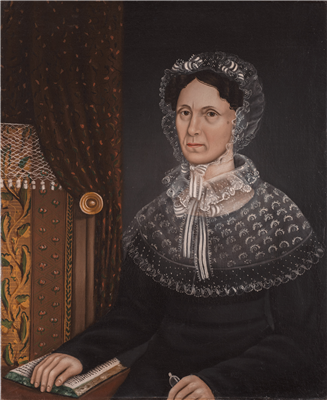Elizabeth Colt commissioned fine arts painters like Charles Loring to create two portraits, one to memorialize her husband Samuel and a complimentary work of Elizabeth with her only surviving child into adulthood, Caldwell. What kind of portraits were commissioned and composed for the more “ordinary” citizen in Hartford? Through the text, “Meet Your Neighbors: New England Portraits, Painters & Society-1790 to 1850,” I am able to form a deeper understanding of the role portraiture played.

Image Credit: http://www.thewadsworth.org
Portraits are a prism, an immediate, “compelling window on the past, providing tangible information about their subjects and the world in which they lived.” In the first half of the 19th century there was an explosion of consumers, anonymous men and women who commissioned family portraits. These works were not products of the elite class and not until the second half of the 19th century did an academic style develop. Unlike in Europe, America did not have academies to provide instruction though there were handbooks written by European academics for the contemporary artist to hone his or her skills as a painter.
The role of the portrait represented “a definable individual within his or her social milieu,” a tangible token of celebration, and in some cases a symbol of achievement. 17th and 18th century portraits of distinguishing magistrates, powerful clergymen, merchants and country squires, those members of the elite were smothered by the more widely available, production of simple, inexpensive portraits. New technology, oil paint in a tube for example, aided artists in their access to customers to create compositions within the domestic sphere. These expressions of the material life of ordinary persons and their everyday lives are submerged in symbols that link gender, age, occupation and the family role of each sitter.
Portraits depicted a likeness of the sitter through primary colors, limited shading and pronounced two-dimensionality. They reveal gender roles and underscore the separate sphere of the sexes. Women immersed in motherhood contrasts with the husband’s absorption in business. This is delineated through objects included in the picture, the male figure, committed to the pursuit of information is shown with papers, quill pens, and accounts. The woman may hold her child or small volumes that include works of devotion or the Bible. In her receptive role, she holds a book, reads the book rather than writing it. Portraits showcase a woman’s sense of fashion and materialism through adornments in her dress or a skill like needlework.
Finished portraits were displayed in the parlor What I find fascinating is the embedded symbols in the work and their attachment to the narrow roles men and women played in the household. That iconography and imagery of those faces speak to the rigidity patriarchy spun in the history of an individual life in Hartford.
Below is an example of an American portrait from the early-19th century housed at the Wadsworth Atheneum. I am currently in search of a portraits in this time frame that were commissioned in Hartford. Stay tuned!

Image Credit: http://www.thewadsworth.org
